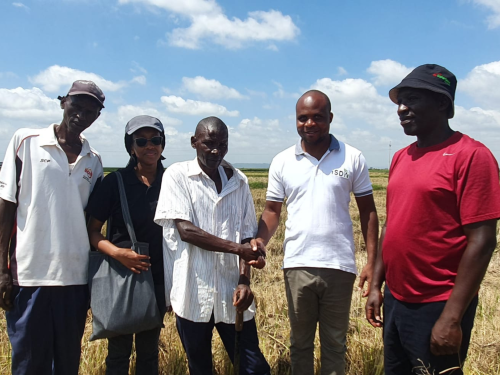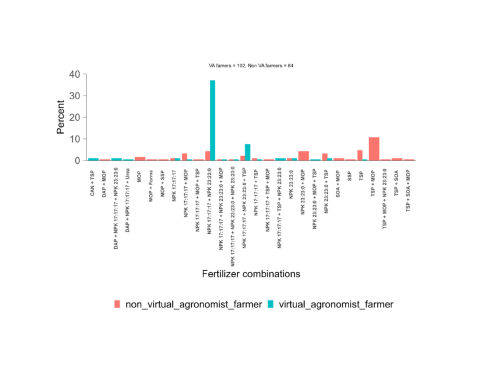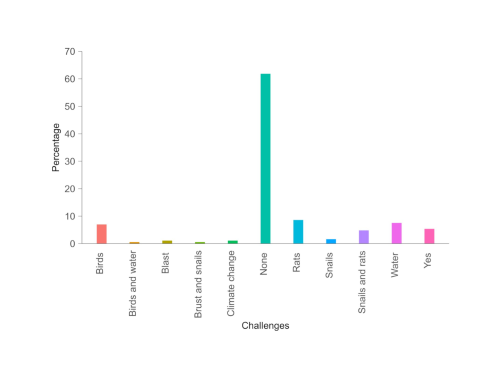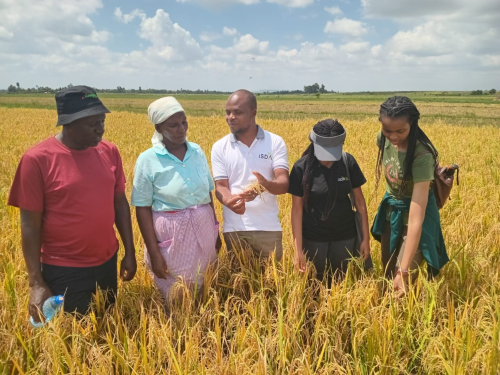Rice production is central to Mwea’s agricultural identity, contributing significantly to Kenya’s food security and economy while supporting thousands of smallholder farmers. However, challenges such as resource inefficiencies, soil degradation, and the need for precise farming practices make it difficult to meet growing demands sustainably.
To tackle these issues, our team at iSDA conducted a retrospective cohort study to assess the impact of our Virtual Agronomist AI advisory service compared with normal Farmer Practice in the Mwea Rice Scheme in Kenya. Designed to deliver tailored, data-driven recommendations, our Virtual Agronomist advisory service aims to enhance farming practices and boost productivity for farmers across Africa.
The findings not only highlight the potential of Virtual Agronomist to transform farming in Mwea but also provide valuable insights for future improvements and scaling the technology to benefit more communities. This initiative reflects our commitment to equipping farmers with the tools they need for sustainable, high-yield agriculture.
Rice Farming in Mwea
Rice is a staple food for nearly half of the world’s population, with global demand estimated to be at 523.8 million metric tonnes. In Africa, rice demand currently stands at 70 million metric tonnes, but with population growth and increasing rice consumption per capita, it is projected to more than double by 2050.
In 2020, Kenya’s annual rice consumption alone was estimated at 700,000 metric tonnes, while domestic production remained significantly lower at just 85,000 metric tonnes. The Mwea Rice Scheme, located 100 kilometres north of Nairobi, accounts for 80% of Kenya’s locally produced rice. Spanning 8,000 hectares, the scheme supports around 6,000 farming families. However, reports indicate a worrying decline in productivity, dropping from 5.6-6.0 tonnes per hectare to 1.3-4.6 tonnes per hectare between 1977 and 2018.
Rice farming in Mwea faces challenges such as soil degradation, water scarcity, pests, and diseases. These issues, worsened by climate change, hinder productivity and sustainability, and many farmers lack access to reliable agronomic knowledge, making it difficult to optimise their farming practices.

Members of our iSDA team with Mwea rice farmer Mugo who used our Virtual Agronomist AI advisory service this season
To help address these challenges, iSDA introduced Virtual Agronomist to farmers in Mwea. The tool provides tailored recommendations using machine learning and remote sensing technologies. It offers insights on crucial agronomic practices including managing soil health, fertiliser use, pest and disease control, and harvest monitoring, empowering farmers to make better-informed decisions. By bridging the gap between traditional farming practices and modern technology, Virtual Agronomist aims to improve productivity and resilience in Mwea’s rice farming communities.
Survey Background
In 2024, 396 Virtual Agronomist nutrient management plans were implemented in Mwea. To study their impact, members of our team surveyed 102 randomly chosen Virtual Agronomist farmers. They also identified 84 nearby farms as “control plots,” where farmers used normal farmer practice instead of implementing recommendations suggested by our Virtual Agronomist service. Both groups were asked the same set of questions through a standardised survey and our team measured field sizes using GPS to accurately calculate crop yields in terms of grain bags per hectare. Women made up about 35% of farmers in both groups, and the average field size was around 0.4 hectares.
Key Findings from Survey
Productivity Gains, Lower Costs and Higher Profits
The implementation of Virtual Agronomist in Mwea yielded remarkable results, demonstrating its potential to transform rice farming. Our survey found that farmers who adopted the tool experienced an impressive 18% increase in yields compared to those who did not use the service, increasing average crop yields by 1 tonne per hectare, from 5.4 tonnes/hectare to 6.4 tonnes/hectare. The yield data (see graph below) shows that Virtual Agronomist improved yields across all levels. For example, 56% of farmers using Virtual Agronomist achieved yields over 6 tonnes per hectare, compared to just 29% of those using traditional methods. Additionally, 9% of Virtual Agronomist farmers produced more than 8 tonnes per hectare, while no farmers using traditional practices achieved such high yields.
This boost in productivity was linked to the adoption of good agronomic practices, such as balanced fertiliser application and optimised resource use, as guided by Virtual Agronomist.

Yield distribution for Virtual Agronomist (VA) and Farmer Practice (FP)
It was also found that farmers using Virtual Agronomist spent 15% more on fertiliser compared to farmers using their own practice. While yield improvements were modest, the average profit of this already high yielding system increased by 21%, from $2,720 per hectare with traditional methods to $3,290 per hectare with Virtual Agronomist.

Profit distribution for Virtual Agronomist (VA) and Farmer Practice (FP)
Tailored Advice & Improved Farming Practices
From the survey, it was discovered that farmers using their own practice were spending their money on inappropriate types of fertiliser products. One of Virtual Agronomist’s standout features is its ability to adapt fertiliser recommendations to the unique soil properties of different regions. iSDA’s digital soil map of Africa revealed that Mwea’s soil contains naturally high potassium levels, and despite this, farmers who used their own practice generally applied fertilisers with higher levels of potassium which were not needed. In contrast, Virtual Agronomist recommended higher nitrogen fertiliser rates than own-practice farmers used.
Farmers who used Virtual Agronomist were guided to apply balanced fertilisers at the start of the season, ensuring the inclusion of all three critical nutrients: Nitrogen, Phosphorus, and Potassium (NPK). This approach contrasted sharply with the practices of many farmers who did not use the service. Among non-users, approximately 49% of own-practice farmers used basal fertilisers (fertilisers added before or when a crop is planted) that did not contain any nitrogen. The lower nitrogen levels likely led to reduced yields for farmers using their traditional methods, as nitrogen deficiency likely stunted the growth of rice seedlings.

Graph showing different fertiliser products used by Virtual Agronomist and Farmer Practice farmers
Our Virtual Agronomist AI advisory service recommends splitting topdressing (fertilisers added to the surface of the soil after planting) into two or more applications to reduce nitrogen losses and increase fertiliser use efficiency. About 81% of Virtual Agronomist farmers followed this advice, compared to only 45% of farmers using their traditional methods. Most farmers used sulphate of ammonia as their topdressing nitrogen source, however, this product is often more expensive than urea per unit weight and contains less than half the amount of nitrogen, resulting in higher application and transport costs. Farmers mentioned that they had previous avoided using urea because they believed it could harm their plants during dry spells. However, there’s no scientific evidence to support this with soil-applied urea, especially in lowland irrigated rice fields at the time of top dressing when plants are already well established.
Sustainability Impact
Our survey revealed critical insights into the sustainability challenges and practices among rice farmers in Mwea, highlighting areas for improvement and long-term resilience.
Approximately 10% of the farmers identified water scarcity as a major challenge affecting their yields. Other yield reduction factors reported included pests—particularly birds, rats, and snails—as well as diseases like rice blast. Virtual Agronomist’s plant health scouting tool was not available to farmers in time for this season and we hope to see the tool improve farmers diagnosis of pests and diseases during next season. The pests identified this season are now being included in the Virtual Agronomist plant health scout and advisory tool going forward.

Graph demonstrating sustainability challenges faced by Mwea rice farmers during the season
These findings highlight the critical need to address water management challenges, control pests and diseases, and encourage sustainable farming practices to boost productivity and strengthen resilience in Mwea. Virtual Agronomist has proven its ability to steer farmers toward more sustainable approaches, paving the way for lasting agricultural and environmental improvements.
Farmer Adoption Rates
Although Virtual Agronomist was introduced to a small subset of Mwea’s rice growers, its impact was substantial and indicative of its potential for wider adoption. Our team at iSDA worked with 336 farmers within the scheme - a fraction of Mwea’s estimated 14,000 rice producers. Despite the limited initial rollout, the engagement levels among participating farmers were exceptionally high.

iSDA's Paul Chunga, Tume Elema, Abi Wairimu and Patrick Wanyaka reviewing rice crops with non-Virtual Agronomist farmer Lucy
Farmers showed strong interest in a version of Virtual Agronomist designed for ratoon rice crops. This method, which is becoming more popular, involves cutting rice stems at harvest and letting the plants regrow to produce a second crop without replanting. Although ratoon crops usually yield about half as much as the main crop, they are still profitable because input costs are much lower. In response, iSDA created a version of Virtual Agronomist specifically for ratoon crop farming, showing how quickly they respond to farmer needs and turn feedback into useful solutions.
Farmers who used Virtual Agronomist actively followed the tool’s advisories, particularly its fertiliser recommendations, which played a key role in improving farming practices and boosting productivity. The success of the service among these early adopters has sparked significant interest across the wider farming community in Mwea. The majority of farmers surveyed expressed a willingness to pay for Virtual Agronomist in the future, with 85% of traditional practice farmers and 94% of current VA users supporting the idea.

Mwea rice farmer Anthony discussing his results with iSDA's Paul Chunga and Patrick Wanyaka
iSDA’s earlier case studies have shown the benefits of Virtual Agronomist in low-yielding environments. The Mwea case study, however, highlights the advantages of Virtual Agronomist in high-intensity farming systems. Its use resulted in moderate yield improvements across all levels, better precision in choosing and applying fertilisers, lower fertiliser waste, and increased profitability for farmers across different production levels.
Over 90% of Virtual Agronomist users in Mwea were satisfied and plan to keep using it, while many non-users showed interest in adopting the service. This shows the potential to expand Virtual Agronomist to other regions, crops and farming systems, helping farmers boost productivity, save costs and adopt sustainable practices.
The success in Mwea highlights the need for advanced agronomic tools to address farming challenges and improve yields. We call on governments, NGOs, agribusinesses, and development partners to support the widespread adoption of these tools across Africa, empowering farmers and promoting sustainable agriculture to ensure food security across the continent.
To learn more about Virtual Agronomist, click here.



